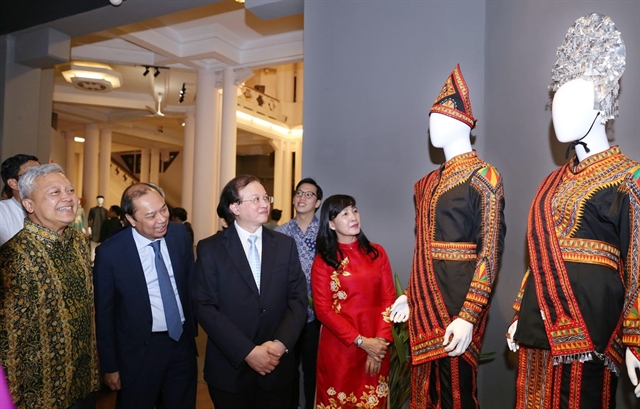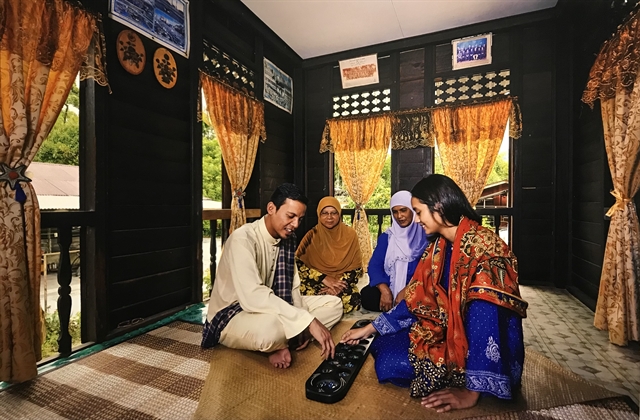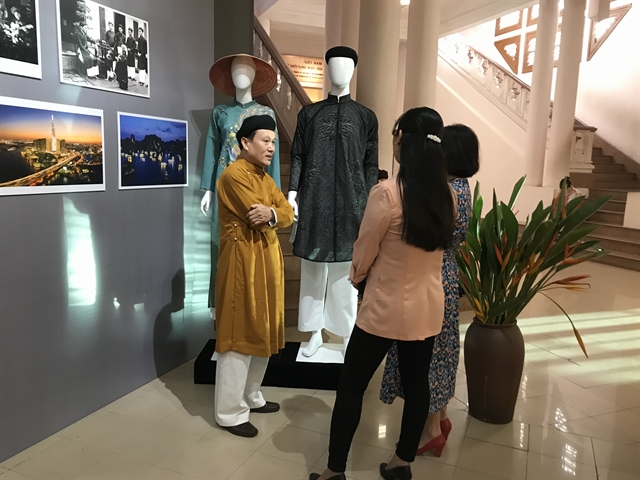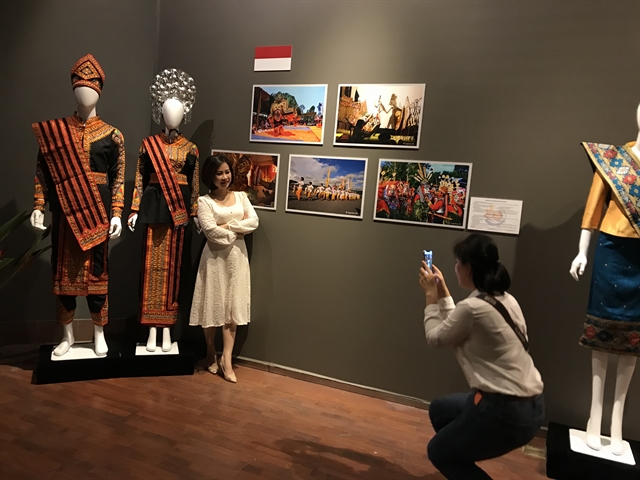HÀ NỘI An exhibition featuring traditional costumes of ASEAN nations is opening at the National Museum of Vietnamese History in downtown Hà Nội.
The event is co-hosted by the museum, the culture ministry and ten embassies of ASEAN members in Việt Nam, which aims to strengthen close ties between nations and to celebrate 2020 when Việt Nam acts as the chair of the group.

Deputy Minister of Culture, Sports and Tourism Tạ Quang Đông (third from left) and delegates at the exhibition. VNA/VNS Photo Hoàng Hiếu
Typical costumes of men and women in each country are showcased together with images of local lifestyles and cultures and a clear explanation of colours, decoration patterns used in the costumes.
For example, traditional costumes in Laos are called Sinh (for women) and Salong (for men).
Sinh consists of three major parts namely Phuen Sinh – the main part of the dress usually woven with one or two different colours; Hua Sinh – the waistband that will be concealed when worn; and the Tdin Sinh – the foot of the Sinh, that is also the most elaborate part, sometimes even decorated with gold.
Lao women wear Sinh with a short-sleeve shirt that is elaborately embroidered with birds and flowers motifs.
Salong is a round neck shirt that is buttoned with fabric buttons, combined with short pants and wrapped a colourful scarf, which is called “Pha nhao nep tieu”. Lao men wrap the scarf around the hip, pull it between the legs and secure it with a waistband at the back. Some men also wear a scarf called a “pha-biang” around the chest.

A photo features Malay people in traditional costumes. VNS Photo Lê Hương
Baju Kurung, which loosely translated as “enclosed dress”, is a traditional costume for Malay women in Malaysia. Baju Kurung comprises a knee-length blouse over a sarong (skirt). Usually, a full traditional Baju Kurung comes with a long scarf that can be hung over the shoulder, and sometimes it can be used to cover the head.
The Baju Kurung was designed to adhere to the rules of Islam.
The costume has developed into three main kinds of styles namely Traditional Baju Kurung, Baju Kurung Kdah and Baju Kurung Modern.
Baju Melayu is a Malay male attire and can be classified into two types namely Baju Teluk Belanga and Baju Cekak Musang.
Baju Melayu is worn over trousers and coupled with the addition of a cloth, as well as “samping” which is wrapped around the waist. Baju Melayu looks more radiant when coupled with a songket or samping. It can add extra elegance to the costume. Baju Melayu is not just a costume but it is necessary for traditional practices.
A set of Vietnamese áo dài (long dress) for men and women is displayed at the exhibition as the traditional costume of Vietnamese people.

Visitors learn about Vietnamese costumes at the event. VNS Photo Lê Hương
Today’s áo dài was developed from a five-panelled aristocratic gown. In the reign of Nguyễn Phúc Khoát (1739-1765), he issued a regulation to promote the five-panelled aristocratic gown. Later, the Nguyễn dynasty inherited and reformed the costumes prescribed by the Lords, including the five-panelled aristocratic gown. In particular, in the 1836-1837 period, King Minh Mạng decided to radically reform clothes in order to unify the dress of Việt Nam.
Since then, the five-panelled gown has been considered the national dress, developing with the costumes of the ethnic communities in Việt Nam.
A five-panelled aristocratic gown has five flaps connected together; the neck, right square cross button; wide and over the knee flap; and sleeves tied at the cuffs.
From 1939, painter Cát Tường initiated the reform of the five panelled aristocratic gown of women, creating a new turning point for the five-panelled gown. Previously, the beauty of a Vietnamese woman is expressed through a spacious and simple five-panelled gown, now the beauty is revealed more openly thanks to some improvements such as enlarged neck, short arms, the body of the shirt hugging the chest and body, honouring the curvature of the woman’s body.
The styles, materials, colours and decorative patterns of the current women’s áo dài are very diverse.
This change is consistent with the European movement as well as the movement for equal rights of women in Việt Nam.
Women’s áo dài are still constantly innovating, white the five-panelled aristocratic gown for Vietnamese men has almost been withdrawn from contemporary life.
Recently, the men’s gown become more appealing, in parallel with the áo dài for women.
Addressing the opening ceremony on October 21, Deputy Minister of Culture, Sports and Tourism Tạ Quang Đông highly appreciated the members in taking part in the event.
“Though the COVID-19 pandemic is still going on, the ten members have actively co-ordinated with the organisers to send costumes and photos,” he said. “This confirms their concern for cultural events hosted by Việt Nam this year to create a cultural space so that each person in the bloc and international friends know more about ASEAN’s identity and solidarity to overcome challenges together.”
Ibnu Hadi, Indonesian ambassador to Việt Nam, highly appreciated Việt Nam’s role as chair this year.
He hoped Việt Nam and ASEAN will host more activities to enhance the community’s awareness on the ASEAN bloc and boost mutual understanding between members.
The exhibition runs at the museum, No 1 Tràng Tiền Street, Hà Nội, till October 28. VNS

Visitors take photos at the event, which aims to strengthen mutual understanding between ASEAN members. VNS Photo Lê Hương
OVietnam